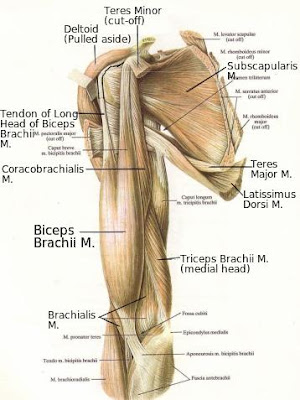The biceps brachii is a strong, spindle-shaped muscle of the human arm. It lies along the full length of the anterior side of humerus, stretching over the coracobrachialis and the brachialis muscle. It originates by two heads; the long head arises by a long tendon from the supraglenoid tubercle of scapula (right above the glenoid cavity where the head of humerus articulates). Then it runs over the head of humerus, extending down laterally to fuse with the short head into one muscle.
The short head of the biceps brachii, on the other hand, originates from the coracoid process of scapula and travels down medially, over the coracobrachialis muscle, to join its contralateral portion halfway the length of humerus. Then the biceps brachii muscle keeps stretching down the lower half of humerus as one long fleshy belly, covering the brachialis, to be inserted by a sturdy tendon into the radial tuberosity in the proximal portion of radius.
Action
The biceps brachii folds the upper limb at the elbow-joint, pulling the forearm up towards the anterior side of arm (this is the muscle you use when you do curls at the gym). Along with the anterior portion of deltoid, it also raises the arm forwardly. It also assists the supinator muscle to twist around the forearm into the supine position.
Innervation
This powerful muscle is innervated by a side branch of the musculocutaneous nerve (C5-C6)
Blood Supply
The biceps brachii muscle is supplied by muscular branches of both axillary and brachial artery.
Below, muscles of the arm, showing the biceps brachii stretching superficially over the coracobrachialis and the branchialis muscle.

0 $type={blogger}:
Post a Comment